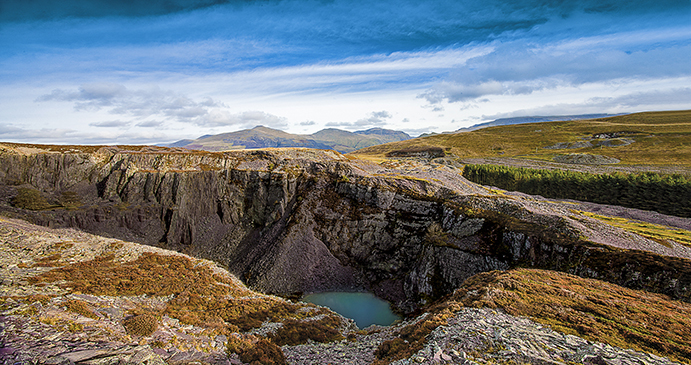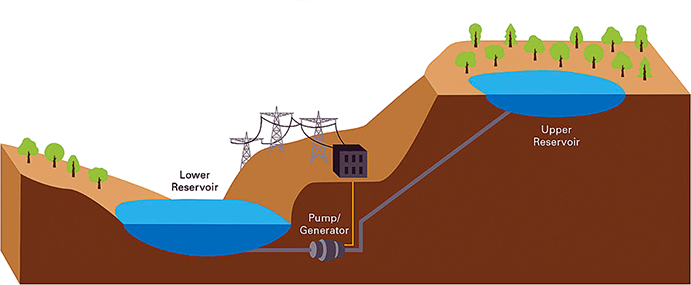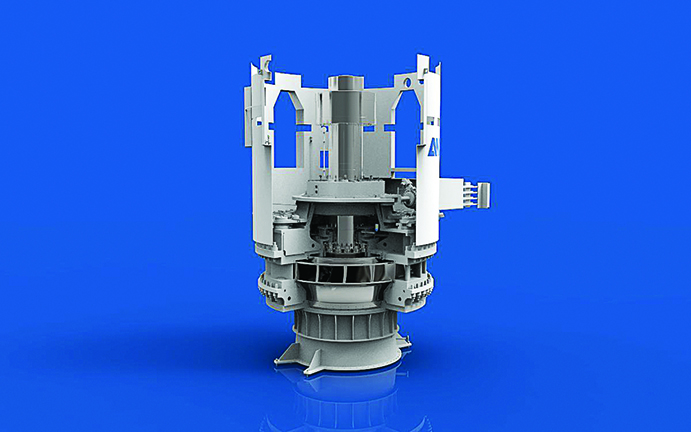In pumped hydro storage there is a tried-and-tested technology that not only fits the bill for future energy needs but has been doing the job for well over a century. Andrew Wade reports
It’s often assumed that to mitigate the worst effects of climate change we need an energy revolution incorporating a raft of new ideas. However, the core technologies needed to decarbonise the power sector already exist in the form of renewables, with wind and solar now the fastest-growing sources of new generation.
One major problem, as critics are quick to point out, is intermittency. If that problem could be solved, the energy sector could be transformed within a few short decades. And, as it happens, several countries are betting that we already have the answer.

In pumped hydro storage there is a tried-and-tested technology that not only fits the bill but has been doing the job for well over a century. First employed in the 1890s, pumped hydro makes up 97 per cent of energy storage worldwide, with around 168GW currently installed. Excess off-peak grid power – theoretically from renewables – is used to pump water uphill, where it’s stored as gravitational potential energy. When electricity demand is high, water is released downhill to power turbines, the elevated reservoirs essentially acting as giant batteries to help balance the grid.
Currently, the UK has four operational plants. When the youngest – Dinorwig in Snowdonia – was built over 30 years ago, it was the largest civil engineering contract ever awarded by the government. Today, just up the road in Glyn Rhonwy, a new pumped storage venture is being developed by private company Snowdonia Pumped Hydro (SPH). With 99.9MW of output and 700MWh of storage capacity, it won’t solve the climate change problem singlehanded. However, the process behind its selection also threw up hundreds of other viable UK sites. By exploiting just a handful of these, pumped hydro could be the last missing piece of the UK's clean energy puzzle.
“We basically started with a few databases of lakes, mines, quarries and so on, and we wrote a little algorithm that would compare them, to see how close they were and try and make matches,” explained Dave Holmes, managing director of Quarry Battery Company (QBC), the parent firm behind SPH.
“We got down to maybe 1,000 sites, or potential pairs, and then we cruised around the country on Google Earth having a look at them all and trying to figure out which ones were the best.”
The dual bodies of water ideally need to be similar in size, with a suitable disparity of altitude, or head. As well as identifying sites that were technically desirable, the team had to consider other factors such as planning risk, proximity to the grid and nearby areas of conservation. Glyn Rhonwy’s two disused slate mines ticked a lot of boxes.
“There were a few things in its favour,” said Holmes. “It’s pretty close to the National Grid transmission system. The length of the tunnel that you need in comparison to the head; it’s a very steep site, which means the tunnel we’re building isn’t too long. The gradient is actually quite a challenge. It’s 19 per cent… and we’re looking to go in a single slope all the way to the top.”
The site also happened to be owned by the local council, which had plans to develop the lower reservoir into an industrial estate. Accommodating SHP’s powerhouse would not be a huge departure.
“We see it as recycling the land rather than using some new land for the site,” said Holmes.
Glyn Rhonwy gained approval for a 49.9MW plant several years ago, but changes in the energy market prompted SPH to rethink the design. The revised plan for the 99.9MW facility was greenlit in March 2017. According to Holmes, the only significant change was the inclusion of two 49.9MW turbines instead of the original pair of 24.95MW devices.

“We found there was more capacity there than we first understood, and it would have been a waste of that capacity to not have a more powerful turbine on it,” he explained.
The National Grid’s capacity mechanism also helped incentivise the change. Despite having 600MWh of storage in the original plans, SPH would have been rewarded only for its 49.9MW output. By doubling that to 99.9MW, the project will double the income it earns via the mechanism. The revised 700MWh capacity will be enough to supply 200,000 homes with electricity for seven hours a day. Although construction costs will increase from £140m to £160m, Holmes believes the payback period on the investment should be halved to under 10 years – a fraction of the plant’s projected 125-year operational lifetime.
“It’s a very exciting time because we can see a light at the end of the tunnel,” he said. “We’re hoping to break ground sometime next year, but it could be early the year after.”
As construction gets under way in Glyn Rhonwy, a pumped hydro plant of an altogether different breed will be nearing completion some 8,000km away. Located just to the north of Beijing, the Fengning Pumped Storage Power Station will have an installed capacity of 3,600MW, making it the largest pumped hydro facility in the world. Its generators will be fed by an upper reservoir holding nearly 49 million cubic metres of water – enough to fill about 19,500 Olympic pools. By comparison, each of Glyn Rhonwy’s reservoirs will hold just over 1 million cubic metres.
The $1.87bn (£1.42bn) Fengning plant will be equipped with 12 x 300MW pump turbines in a single cavern. Ten of these will be fixed-speed units contracted from local suppliers. The final two will be variable-speed pump turbines provided by Andritz, the Austrian engineering giant with a long history in hydro power.
“The major difference is in a completely different generator design,” Alexander Schwab, Andritz SVP of market management, explained to The Engineer. “With conventional synchronous generators, the number of poles and the frequency of the grid are defining the rotational speed of the unit. That defines the design speed of the turbine/pump. Consequently, for pump turbines it is necessary to find a compromise between optimal turbine and optimal pump.”
According to Schwab, the variable turbines will allow operation ranges for pumping and generating to be designed individually. This should enable Fengning to better manage its output and provide more grid flexibility.

Andritz has previously installed the technology at Germany’s Goldisthal pumped storage facility, but this is the first time variable speed units will be used in China’s ever-expanding hydro sector. “Taking all the facts into consideration, it will be a project needing the utmost attention from the Andritz side,” said Schwab.
When Fengning comes online, China will have three of the four biggest pumped storage facilities in the world. The technology is seen as increasingly vital if the country is to wean itself off the coal that has powered the industrial progress of recent decades. Air pollution across China, particularly around Beijing, has reached such worrying levels that it is no longer simply a public health issue. Speaking recently, the country’s environment protection minister, Li Ganjie, admitted that air quality had become a matter of social stability. Although it remains the world’s biggest polluter, China has committed to reducing CO2 emissions by 60-65 per cent before 2030. If this is to be achieved, massive expansion of renewables, coupled with pumped storage, will need to play a key role.
Back in the UK, plans are afoot for another major project. While not on the same scale as Fengning, the Coire Glas pumped hydro plant will boast an output of 1,500MW. It will lie to the east of Fort William, in the Great Glen of the Scottish Highlands. Using Loch Lochy as the lower body of water, developer SSE plans to build an upper reservoir 500m above, with a relatively steep incline delivering good energy efficiency.
The project received planning permission several years ago for a smaller 600MW plant but, similarly to Glyn Rhonwy, those plans have had to be scaled up in a bid to make the project more commercially attractive. In May 2017 SSE submitted a scoping report for the revised scheme, and a decision from the Scottish government is expected in the near future. Importantly, Coire Glas will have the capacity to store a massive amount of energy – around 30GWh – more than all existing UK storage capacity combined, according to SSE. The firm says this will help provide the flexibility required for integrating more renewables, as well as the changing usage patterns expected from the growth in electric vehicles.
“SSE considers there to be clear benefits in the delivery of new pumped storage projects in the UK,” Coire Glas project manager Andy Gregory told The Engineer. “It’s a proven technology that can be deployed at the tens of GWh scale, with a short response time and the ability to provide a number of important services to the system.”
Across the UK there are hundreds of potential pumped hydro sites, with the low-hanging fruit adding up to around 50GWh. According to QBC’s Holmes, these are mainly in Scotland and Wales due to topography.
“Our best guess at how much is economic already or will be economic soon is around 50GWh,” he said.
Some of these sites are similar in nature to Glyn Rhonwy and Coire Glas, where dual bodies of fresh water would work in tandem. Other sites, however, are less conventional. QBC has been awarded funding to explore the viability of non-standard sites around the UK, looking at seawater, drinking water and lower-head opportunities.
Seawater, in particular, presents both a unique opportunity as well as unique challenges. Using the sea as the lower ‘reservoir’ unlocks a host of locations that would previously have been overlooked as, in theory, all that’s required is elevated land close to the coast. But seawater brings complications such as fouling and corrosion, and using the open sea can impact on marine life, and have unwanted effects on the coastal profile.
To date, just a single seawater project has been commissioned – Japan’s Okinawa Yanbaru Seawater Pumped Storage Power Station. Built in 1999, it featured a striking octagonal upper reservoir set into the lush coastal vegetation. Instead of steel, the penstock was made of fibre-reinforced plastic to avoid corrosion and barnacle fouling, and the pump turbine included stainless steel to improve seawater resistance. Although widely hailed as an engineering success, the plant was shut down in 2016 as it no longer fitted local power demands.
Despite just one pilot project, seawater pumped storage is being explored in several countries, including the UK. South Australia’s proposed Cultana plant could generate 225MW of electricity with eight hours’ storage. The region already supports renewables, but arid conditions make traditional pumped hydro tricky. Combining existing solar and wind generation with coastal storage plants promises to be an innovative solution.
Elsewhere in Australia the planned Snowy Hydro 2.0 project will look to add pumped storage to the long-established hydro generation already in place. If completed, it will add generation capacity of 2,000MW and a massive 350GWh of storage. This year, a government-backed study by the Australian National University (ANU) into other viable locations identified 22,000 sites, the bulk of which are on the more densely populated east coast. Combined, these could provide around 67,000GWh of storage.
“We need to build only about one or two dozen to support a 100 per cent renewable electricity grid,” Andrew Blakers, a professor of engineering at ANU and one of the report’s authors, said recently.
“Pumped hydro, high-voltage DC interconnectors between the states, wind, batteries and demand management can do the whole job. Not just for electricity, but the whole job for energy: electrifying land transport, electrifying heating and cooling. You can have 75 per
cent cuts in Australia’s greenhouse gas emissions by electrifying nearly everything, and I think this is what’s going to happen over the next 15 to 20 years.”
The UK’s topography may not be as rich as Australia’s in terms of potential sites but there are ample resources to exploit. If tidal lagoons finally get the green light, they could also include a pumped hydro element, as well as help balance the grid via their natural geographic dispersion. And, with wind and solar costs still tumbling, there’s no reason why the UK couldn’t fully decarbonise over the next two decades. The fact that the Aussies are already in the race can only bring added incentive.
For more stories on renewable energy and its application, click here




JLR teams with Allye Energy on portable battery storage
This illustrates the lengths required to operate electric vehicles in some circumstances. It is just as well few electric Range Rovers will go off...